The rate of online shopping exploded at the start of the Covid-19 pandemic and is continuing to grow.
There are not only more online shoppers but also more ecommerce stores and competition. As an ecommerce store owner, it’s crucial to optimize your website to provide the best experience possible for your customers.
In this in-depth guide, I’ll discuss:
- What is customer experience (CX)
- Why CX is important
- 23 ways to enhance your ecommerce customer experience
- Much more
Let’s get started.
What is Customer Experience (CX) in Ecommerce?
Ecommerce customer experience is the overall feeling and sentiment your online visitors feel when going through your store.
It’s about how well-designed your website is, how easy it is to perform the desired action, how fast pages load, and much more.
In other words, customer experience is how well your website satisfies each visitors’ need.
All these different qualities of your ecommerce store combine to form a perception in your visitors’ minds.
Why is Customer Experience (CX) Important?
Customer experience, or CX, is often vastly overlooked by ecommerce store owners because they focus all their attention on marketing.
However, improving customer experience is a part of marketing your brand in itself.
Creating a high-quality shopping experience for your visitors is a surefire way to:
- Increase conversion rates
- Improve customer retention
- Strengthen customer referrals
- Grow customer loyalty
The same thing is true in regular retail stores.
Think about the most memorable retail stores you’ve ever visited. Those stores most likely had helpful in-store associates, quick service, a logical store design, and easy-to-find products.
The ecommerce stores that go above in beyond in providing their visitors an unrivaled experience will be successful in the long run.
Furthermore, poor customer experience is detrimental to your ecommerce store because 88% of online visitors are less likely to come back after a bad experience.
Therefore, spending a few days improving the customer experience of your ecommerce store can pay dividends for your business.
Best Ways to Improve Ecommerce Customer Experience
Now, you should understand what customer experience is and why it’s so crucial for ecommerce stores.
So, let’s dive into the 23 best ways to improve ecommerce UX that you can implement today.
1) Improve Website Speed
Online shoppers highly value speed and efficiency. Furthermore, they’re not used to waiting more than a few seconds for a page to load.
In fact, 40% of visitors abandon a website that takes 3 seconds or more to load.
Your website’s load time is the first thing a visitor will experience and the most important as well.
Let’s discuss how to decrease load times on your ecommerce website.
Run a Speed Test
First, test the speed of your ecommerce website using GTmetrix or Google PageSpeed Insights.

After running the test, you’ll see your website’s rating and what specific factors are slowing it down.
Furthermore, the speed test will display what factors on your website are causing slow loading times and how to fix them.
Optimize Images
Regardless of what the speed test shows, the next step is to optimize the images on your website.
Ecommerce stores usually suffer slow load times because of the high number of product images on the website.
For this reason, I recommend using the application Image Optimizer if your website is hosted on Shopify.
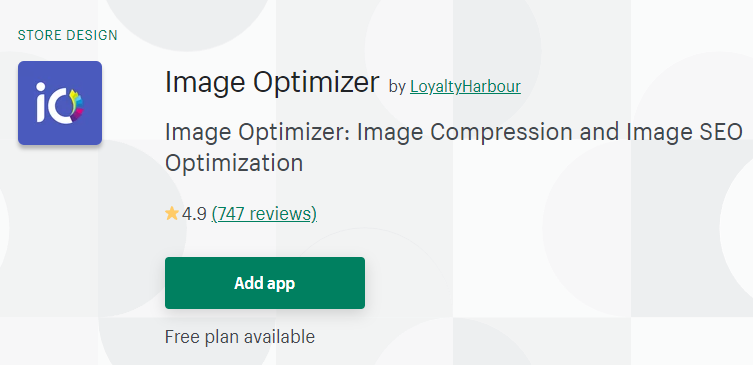
This application will automatically compress every image on your website into smaller-sized files. Furthermore, image quality won’t be sacrificed when the files are smaller.
If you’re not using Shopify to host your ecommerce store, look for a similar application on whichever host you’re using.
Remove Unused Applications & Plugins
Unused applications on your ecommerce store will eat up bandwidth while not providing any proper functionality.
For this reason, examine your list of applications and be sure to delete any that aren’t being used.
After you’ve optimized your website’s images and removed all unneeded applications, make sure to run a speed test again to see if your load time has improved.
2) Create a Mobile-Friendly Experience
When it comes to online shopping on mobile phones, there are many compelling statistics:
- Global mobile ecommerce sales are predicted to be $3.56 trillion at the end of 2021
- Around 79% of smartphone users have used their device to purchase an item in the last six months
Furthermore, 55% of the global population accesses the internet using mobile devices.
As you can see, optimizing your ecommerce store for mobile users is a significant priority.
So, examine your website on a mobile view and see:
- How fast pages load
- If any buttons are hard to click
- If the navigation is easy to use
- Whether the text is easy to ready
- Whether popups provide value
You should go on a comprehensive tour of your website and checkout process to see if everything is optimized.
If you find something that needs fixing, go into your store’s theme editor and select the mobile view. From there, you’ll be able to make any changes you want specifically for mobile devices.
Examining Nike’s Mobile Website

Nike is an excellent example of a website that’s highly mobile-friendly.
The Nike website loads quickly, has high-quality images, and has big, easy-to-read text.
Furthermore, the website offers a great navigation menu, making it easy to find precisely what you need.

Overall, I recommend checking out their website for mobile-design inspiration.
Use a Mobile-Friendly Theme
If you’re having difficulties optimizing your website for mobile, I recommend using a mobile-friendly theme.
Look for themes that are specifically designed for mobile optimization. These themes will have built-in optimizations that allow pages to load faster on mobile devices.
Furthermore, they will include design elements that look better on mobile devices.
3) Avoid Broken Links and 404 Pages
As an ecommerce store owner, it’s not uncommon for broken links and 404 pages to pop up on your website. This is inevitable to happen as you add and remove products from your store.
Broken links deteriorate the customer experience of your online store and cause visitors to abandon your website immediately.
So, implement a redirect plugin on your store that monitors your URLs and automatically creates redirect rules.
You can also use the Google Search Console or Google Analytics to detect any broken links on your website.
4) Personalize Each Customer Visit
Personalizing the customer experience for each specific customer is a proven way of building customer loyalty.
You can accomplish this with personalized product recommendations.
Product recommendations can be given based on products a visitor previously looked at or through a quiz.
Upsell and Cross-Sell
Product recommendations such as upselling and cross-selling can drive 10 to 30% of ecommerce store revenue.
Upselling and cross-selling are both strategies that involve increasing your store’s average order value.
This is usually seen on product pages, checkout pages, and post-purchase pages with additional items that are:
- Directly related to the product
- Complementary to the product
- Personalized for the visitor
One Click Upsell by Zipify is a fantastic upselling and cross-selling app you can download onto your Shopify ecommerce store.
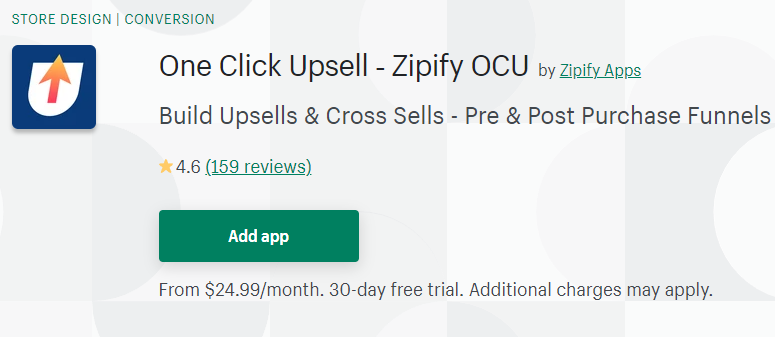
This app offers the ability to create pre and post-purchase upsells. Furthermore, One Click Upsell makes it easy to split test different offers to find the most optimal product recommendations for your store.
Product Recommendation Quizzes
Take a look at this example from Winc, a subscription-based wine company.

Winc’s landing page focuses on getting visitors to take a wine personalization quiz.
After clicking ‘Get Started‘, visitors are directed to a quick 5-question quiz.

After completing the quiz, the user will receive a list of four wines based on their preferences.
Product recommendation quizzes are a fantastic way of personalizing the experience of each visitor and offering products best suited for their needs.
Product Recommendation Quiz is an application you can download on Shopify to start improving the customer experience of your ecommerce store immediately.
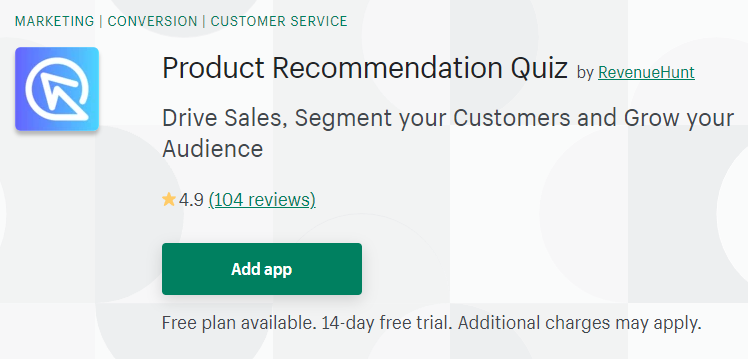
5) Receive Feedback & Optimize
An effective way of improving your ecommerce store’s customer experience is getting feedback directly from the source. Ultimately, it’s the opinions of the online visitors that matter most.
So, you should implement feedback systems in the form of post-purchase surveys and emails. Find out what the customer liked and what could be improved.
Asking for feedback also makes customers more engaged with your brand and personalizes their experience.
This has a higher chance of improving brand loyalty and customer lifetime value.
Shopify has an application called Enquire Post Purchase Survey that provides post-purchase surveys to all customers.

These surveys are non-intrusive, provide value, and get to the bottom of how your ecommerce store’s customer experience is.
6) Easy Navigation
The structure and navigation of your ecommerce store should be organized logically. This makes it easier for your online visitors to find the products they’re searching for.
Because if they can’t find what they’re looking for, they won’t buy it. It’s really just as simple as that.
So, your store’s navigation panel should be easy to access and understand. The categories should make sense, and every category should look the same stylistically.
I recommend examining each of your store’s collections and seeing if any products need to move into different collections.
Furthermore, you may want to create new collections if any of your collections are overwhelmed with different items.
Let’s take a look at Nike’s navigation bar:
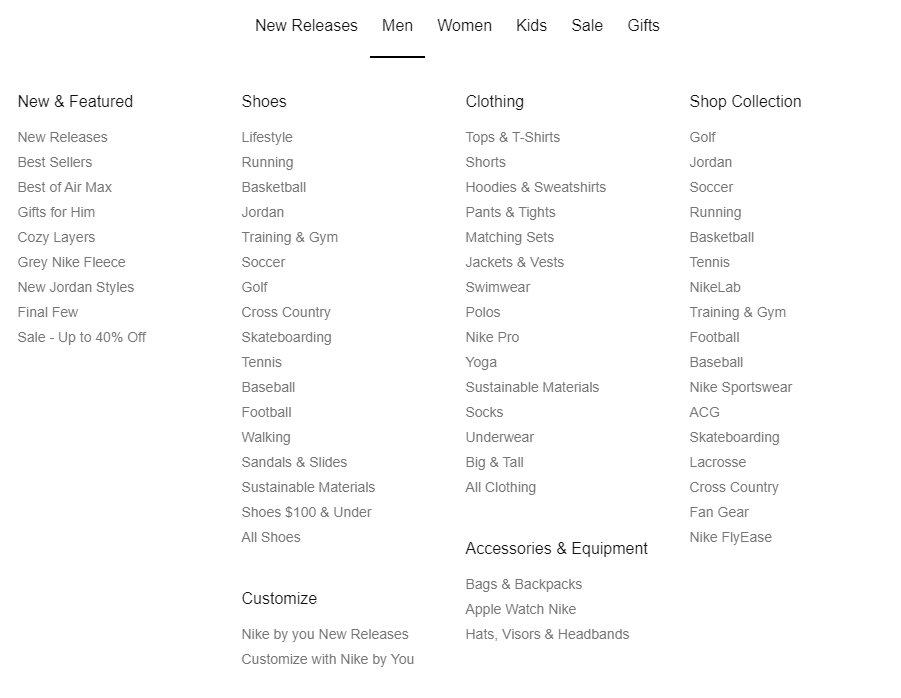
Nike’s men’s products have dozens of different collections and product types to choose from. Having so many options makes it significantly easier to find what you’re looking for.
7) Amazing Customer Support
Your customer support team should be friendly, helpful, and quick to respond to all inquiries.
If your current customer support staff lacks proficient skills, I recommend taking some time to train them.
It’s essential to implement your brand’s values and voice into all communication with visitors.
Your customer support acts as one of the only direct lines of communication with customers. So, your customers’ experience with your support staff significantly impacts how they think about your brand.
8) Risk-Free Return Policy
Having a user-friendly return policy is one of the best ways of enhancing your brand’s value. Online shoppers appreciate when they can easily return something.
So, make sure your return policy is customer-friendly and is easy to find.
Ecommerce stores need to be as transparent as possible with their visitors to prevent complications.
9) Efficient Checkout Process
According to a study completed by Baymard, they found that the average online shopping cart abandonment rate is 69.80%.
Furthermore, research shows that mobile users have an even more extreme abandonment rate of 85.65%.
With these two statistics in mind, it’s important to create a hassle-free checkout process. You should minimize the steps it takes to complete the purchase and offer the most popular payment solutions.
10) Create Detailed Product Descriptions
Online shoppers typically have a variety of different questions they want to ask before purchasing a product.
This is especially true for complex products that need an explanation on how to use them.
So, I recommend writing engaging product descriptions that provide valuable information to potential customers.
Depending on how complex the product is, the description should walk through how the product is used and what the key benefits are.
Remember, shoppers care most about how the product is going to improve their life. They don’t necessarily care about the dimensions of the product or what battery it uses.
Therefore, answer all the potential questions an interested customer may have in a friendly and confident tone.
Good copywriting can drastically improve the customer experience of an ecommerce store.
If you’re looking for some inspiration in product page descriptions, check out the Patagonia website.
11) Design a Beautiful Homepage
Your ecommerce store’s homepage is the first page visitors will see when they click on your website.
Their first impression of your online store plays a significant role in their overall customer experience and perception of your brand.
In fact, a study discovered that 94% of negative website feedback was related to design.
For this reason, you should allocate enough time to redesign your website properly.
Skullcandy has a tech-inspired website with a beautiful homepage design:
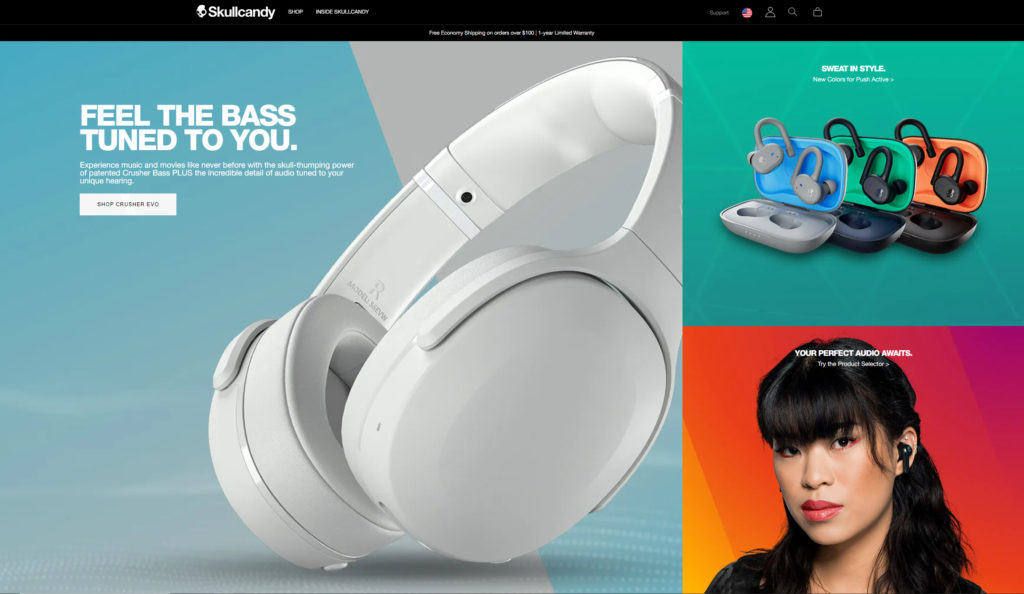
This homepage has three essential offers and three high-quality images. Furthermore, it’s uncluttered, clean, and doesn’t use a lot of text.
Implementation
In modern times, flat design offers the most effective customer experience. Flat design is a user interface style that’s minimalistic and “clean”.
This involves removing any excessive design elements such as glows, shadows, and textures.
In addition, this design style focuses on giving the homepage room to breathe and narrowing in on the call-to-action and offer.
12) Use High-Quality Images
Using high-quality images is highly necessary when designing a beautiful website.
So, all of your product images and homepage images should be HD and without any pixelation.
If your current product images are lackluster, I recommend taking new photos or hiring an agency to take high-quality photos for you.
Think about it like it.
Your ecommerce store visitors cannot touch or see the products in real life before purchasing them.
Thus, you want to use highly detailed photos that show every angle of the product.
13) People Love Videos
If you want to go above and beyond, I recommend introducing videos to your product pages along with high-quality images. Videos are the best way to explain a product and how it’s used in daily life.
From a simple product demonstration to a full-blown tutorial, videos will drastically improve the customer experience of your ecommerce store.
However, the type of video you create depends on the product you are selling.
14) Capitalize on Customer Reviews
Let’s take a moment to learn about how critical customer reviews are:
- 91% of people read online reviews, and 84% trust them as much as recommendations from friends
- The average consumer is happy to spend 31% more on a retailer with great reviews
- Customer reviews are trusted 12 times more than any other marketing material
As you can see, online reviews can make or break your ecommerce store. Just a few positive reviews can improve your store’s conversion rate.
This is because customer reviews build social proof and trust with online visitors. People tend to make decisions based on what others think. In this case, a positive review of a product they’re interested in can be the motivator needed to make the purchase.
Ultimately, online shoppers want proof from other customers that the product is worth purchasing.
For this reason, I recommend using a product reviews application such as Loox if you’re using Shopify.

Loox gives customers the option of attaching a photo along with their customer reviews. Furthermore, the star rating out of five will be shown for each product on the collection and product pages.
15) Provide Several Payment Options
Potential customers can do nothing when they check out their item but don’t see their preferred payment options.
A lack of payment options will result in the loss of many valuable customers.
For this reason, you should optimize your ecommerce store to accept all of the most popular used payment methods.
16) Provide Guest Checkouts
If your ecommerce store requires customers to make an account before purchasing, I highly recommend creating a guest checkout system.
Online shoppers are always in a hurry and want to move on with their day as fast as possible.
So, when they are met with an account creation page before purchasing an item, they may potentially abandon their cart.
For this reason, you should allow visitors to make a purchase exceptionally quickly without the need to create an account.
17) Provide One-Click Checkouts
Even better than guest checkouts is offering one-click checkouts. One-click checkouts allow visitors to instantly purchase an item without having to add it to their cart.
18) Create Brand-Defining Landing Pages
Ecommerce landing pages can significantly improve the first impression visitors have on your website. Furthermore, well-made landing pages are proven to convert better.
But what is a landing page?
Ecommerce landing pages are used to promote specific campaigns with the goal of hooking a customer into making a purchase.
Landing pages are slightly different from home pages and product pages.
Compared to product pages, landing pages are much shallower in content and focus on the core benefits a product gives.
19) Utilize Exit-Intent Popups
Exit-intent popups offer a last-chance opportunity to reach a visitor that may never come back. In fact, 70 to 96% of online visitors never return after leaving your website.
Nowadays, you can use applications such as OptiMonk, which detects when a user is about to leave your website.
The application then displays a last-second popup with a promotion to ultimately convince visitors to make a purchase.
Through exit-intent popups, you can increase email signups, reduce cart abandonment, and improve your store’s conversion rate.
Each popup can be catered to each unique goal and customer.
20) Integrate Social Proof
There are other ways to integrate social proof other than customer reviews.
These include:
- Real-life case studies
- Media mentions
- Social media shares and subscriber counts
- User-generated content
- Trust badges
21) Create a Blog on Your Ecommerce Store
A great way to provide even more value to your store visitors is by creating a blog. This blog should have posts that are relevant to your store’s niche and products.
Furthermore, an effective blog will drive even more organic visitors through Google and search engine optimization.
22) Use Crystal Clear Calls-to-Action (CTAs)
As an ecommerce store, your main goal is to help visitors find what they need and help them purchase it as efficiently as possible.
So, your CTAs like ‘Add to Cart‘, ‘Buy Now‘, or ‘Check Out‘ should be clear, easy to see, and compelling.
Make sure the colors of the buttons stand out on each page and follow your brand colors. Furthermore, I recommend making the font big and easy to read.
23) Post-Purchase Engagement
After a customer places an order, they will constantly be thinking about their order until it arrives. For this reason, it’s crucial to provide them with consistent shipping updates.
So, make sure each customer receives a tracking number with a link that instantly locates where their package is.
Conclusion
Well, there you have it.
The best 23 ways of improving ecommerce customer experience.
I hope that with this guide, you’ll be able to shape up your online store drastically.
Now it’s your turn: Which techniques are you going to implement first?
Did we forget any key methods of improving ecommerce customer experience?
Either way, let us know what you think by leaving a quick comment below.




